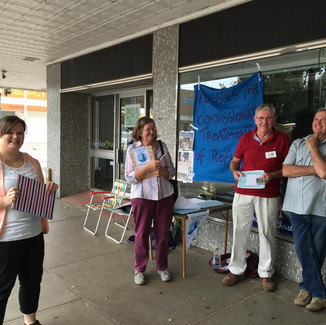A Bit About Petitions
- Jess
- Feb 9, 2016
- 2 min read
A petition is a request for action. I’m petitioning to The House of Representatives, which means that it needs to contain physical signatures. They will not accept online or scanned copies of a petition.
Signature collecting in Wodonga, Melbourne and Benalla.
I decided to write a petition to take with me on my walk because it is an official way to request Parliament to do something. I didn’t want to get to Canberra on the hopes that I might have an audience. This way, my requests will be heard in The House and also recorded for the public and history to see. It also means that the Minister who receives the petition, in this case the Immigration Minister, has to reply, and they have 90 days to do so.
Before I wrote The Welcome Petition I read all of the petitions relating to immigration and asylum seeker policies for the last few years. You can find them through this HERE.
The responses are there too and I was disappointed to find that many of them received the exact same response, just like the one below.

This is a shame because “In early 2008 the House of Representatives changed standing orders (the rules of the House) relating to the way petitions are dealt with, and a Petitions Committee was established to ensure that all petitions presented to the House are considered and receive a response.” http://www.aph.gov.au/Parliamentary_Business/Committees/House/Petitions/Brochure
The system before 2008 needed a review, as petitions weren’t being responded to in an orderly manner. People like Russell Broadbent MP helped to bring about this change so that petitioners could have their concerns addressed. Looking at all those responses from the Immigration Ministers, which are almost the same, it seems like we’re back in the old system.
Anna Burke MP told me that some petitions are not given much attention unless they have lots of signatures. Say, 30,000. This is what I’m aiming for. So far, since 2008, the most amount of signatures on a petition relating to asylum seeker policy is 4,520 approx. Compared with your online petitions like “Get Up”, it’s not much, but collecting physical signatures isn’t easy.

There are a few petitions that have been remembered throughout history such as the Yirrkala Bark Petitions in 1963, requesting recognition of Aboriginal land rights. They were printed beautifully on bark with artwork around the border. You can see them displayed in Parliament House today. The petitions were unsuccessful, however they are the first documentary recognition of Indigenous people in Australian law.
I wanted my petition to begin on a positive note. After the mandatory line: “TO THE HONOURABLE THE SPEAKER AND MEMBERS OF THE HOUSE OF REPRESENTATIVES. This petition of certain citizens of Australia draws to the attention of the House: …” from this point, The Welcome Petition says: “The generosity of the Australian people.” That’s what I’m drawing their attention to, our wonderful welcoming spirit that I’ve always known was there and it’s all I have experienced since I left for Canberra.
In the last few days we have all seen the overwhelming support and offers of sanctuary for asylum seekers and refugees. This is who we are. We are welcoming and generous. We are also very clever and, given the chance, we can help these people live safe and meaningful lives.






























Comments